Spring ![]() Summer
Summer ![]() Fall
Fall ![]() Winter
Winter ![]()

Gazos Creek Beach Access, entrance sign, July 2014 (Jennifer Rycenga)
This small creek mouth and beach, which is officially part of Año Nuevo State Park, appears to be little more than a parking lot to the uninitiated. But to those who know, it contains three fine birding possibilities: a small flock of Snowy Plovers, a gull flock of varying size but high percentage chance of rarities in winter, and the contiguous agricultural fields have yielded more than their share of unusual migrant sparrows in the fall.
Gazos Creek Beach Access (a.k.a. Gazos Creek Mouth) is located on the west side of the intersection of SR1 and Gazos Creek Road; the entrance is north of Gazos Creek Road by about 50 yards. As you take the entrance road in, note the agricultural field you are passing to your right. There is a gully between the entrance road and the fields, with a few makeshift bridges (though it is often easy enough to cross without them). This is the field where the migrant sparrows are found. Song and Savannah Sparrows tend to be common. White-crowned and Golden-crowned Sparrows are usually present, too; the excitement is looking for a rare Harris's Sparrow amongst them. Lincoln's Sparrows can be found in migration, with the rarer species including Brewer's, Clay-colored, Chipping, and Vesper Sparrows. It seems possible that a Snow Bunting or any Longspur could be amongst the rarities found here in future. All this area needs is more birders looking!
The access from the parking lot to the beach is an easy walk. The gull flock at the mouth of Gazos Creek has included Thayer's Gull, Glaucous Gull, and Franklin's Gull (spring). Red Phalaropes have been noted here when weather conditions blow them inland. The Snowy Plover flock is small but steady, monitored as part of a PRBO program. The sandy beach has great views back to the northwest of Pigeon Point. This entire site can be done with great satisfaction in under an hour. The Portola Expedition, by contrast, stayed the entire night of October 23, 1769; regretfully, they did not share their bird list from that venture.
Brant, Canada Goose (noteworthy at this location), Surf Scoter, Common Goldeneye, Western Grebe, Clark's Grebe, Brown Pelican, Brandt's Cormorant, Double-crested Cormorant, Pelagic Cormorant, Snowy Egret, Great Blue Heron, Turkey Vulture, Osprey, Cooper's Hawk, Sharp-shinned Hawk, Red-tailed Hawk, American Kestrel, Merlin, Peregrine Falcon, American Coot, Killdeer, Snowy Plover, Black Oystercatcher, Marbled Godwit, Red Knot (uncommon here), Sanderling, Whimbrel, Willet, Red-necked Phalarope, Heermann's Gull, Short-billed Gull, Ring-billed Gull (rare along the coast), California Gull, Western Gull, Herring Gull, Iceland Gull thayeri, Glaucous-winged Gull, Glaucous Gull, Caspian Tern, Elegant Tern, Marbled Murrelet (uncommon here), Band-tailed Pigeon, Mourning Dove, Great Horned Owl, White-throated Swift, Black Phoebe, Common Raven, Barn Swallow, Ruby-crowned Kinglet, Wrentit, European Starling, Nashville Warbler, Spotted Towhee, Lincoln's Sparrow, Savannah Sparrow, Song Sparrow, White-crowned Sparrow, Golden-crowned Sparrow, Chipping Sparrow (rare at this location, migrant), Black-headed Grosbeak, Western Meadowlark, Brewer's Blackbird, Purple Finch, House Finch, Lesser Goldfinch, American Goldfinch
In this guide, "rarities" are defined as those species given an County Abundance Code of 4, 5, or 6.
Greater White-fronted Goose (2013, 2017, 2021), Cackling Goose (2011, 2013, 2017), Tundra Swan (2021), Long-tailed Duck (2015), Little Blue Heron (2009), White-faced Ibis (2014), Black Vulture (2018), Prairie Falcon (2011), Pacific Golden-Plover (2013, 2015), Baird's Sandpiper (2011, 2014, 2016, 2017, 2020, 2021, 2022 in spring & fall!), Pectoral Sandpiper (2009, 2017, 2018, 2021), Red Phalarope (2019), Franklin's Gull, Black-tailed Gull (2019), Black-legged Kittiwake (2017, 2018, 2019, 2021), Slaty-backed Gull (2019), Glaucous Gull (1977, 2009, 2010, 2011, 2013, 2014, 2017, 2018, 2019, 2021), Lesser Black-backed Gull (2017), Royal Tern (2019), Common Tern (2012), Burrowing Owl (2016), Western Kingbird (2009), Tropical Kingbird (2012, 2013), Virginia's Warbler (2009), Hooded Warbler (2016), Prairie Warbler (2009), Palm Warbler (2010, 2012, 2014), Chipping Sparrow (2011, 2014), Black-throated Sparrow (2011), Vesper Sparrow, Brewer's Sparrow, Clay-colored Sparrow (2009, 2010, 2011, 2012, 2015, 2016), Lark Sparrow (2011), White-throated Sparrow (2015), Harris's Sparrow, Rusty Blackbird (2020)
Gazos Creek Beach Access is on SR1, just north of the intersection with Gazos Creek Road. It is south of Pigeon Point and north of Año Nuevo. From the junction of Pescadero Creek Road and SR1, it is almost 8 miles south.
Red Markers: Parking Area or Trail Head
Hover mouse pointer over marker, or click marker, for identification.
This beach access parking lot is free.
The gate is unlocked around 8:00 am, and relocked at dusk. However, it is easy to park across the street and walk in at any hour.
Crumbling sea cliffs, waves, and rip tides can all be dangerous here. The grassy areas have ticks, especially voracious in late spring and early summer. A few years ago, there was a gang committing crimes of property against parked cars along SR1; the advantage to this parking lot is that you are usually within sight of your car while walking there.
There is an outhouse, a picnic table, a garbage can and a recycling bin. Located across the street are a restaurant (Gazos Grill), a gas station and its accompanying minimart.
Because this park is officially part of Año Nuevo, you can call their park office at 650-879-2025 for more information, should it be necessary.
Gazos Creek Beach -- west of Hwy 1 only is a hotspot in eBird, with 198 species in forty-seven of forty-eight time quadrants. Because of the threatened nature of Snowy Plover populations throughout California, it is especially helpful to note if any of them are seen. Please contribute your sightings to the ever-growing database at eBird
The iNaturalist place marker for this area includes this beach and the Coastal Terrace Prairie to the south. The area has benefitted from the "Snapshot Cal Coast" events.
Pt. Reyes Bird Observatory (PRBO) has two projects that might come to the attention of birdwatchers at Gazos Creek Beach Access. One is their long-running study of Western Gulls; if you see Western Gulls with colored leg bands, note the respective legs and colors, and contact PRBO to forward this data to the researchers on this project. There are also some projects connected to Snowy Plover recovery and research; should you see one of these diminutive denizens of the shallow sand cups, look to see if it has leg bands. Please report either banded species to the good folks at PRBO.
The San Francisco Bay Bird Observatory (SFBBO) is conducting a long-range study of gull movements in the Bay Area. California Gulls have been leg-banded with plastic colored bands. If you see any of these gulls, please note the leg and the color of the band; if it is possible to read the number on the band, record that also. This information can be shared directly with Carly at SFBBO (cschacter@sfbbo.org). If the birds also have a metal band, and you can read that number, too, please report that to the National Bird Banding Lab.
Sequoia Audubon Society has sponsored one trip here - an Animal Tracking Field Trip in 2014. Other SAS field trips have made quick stops here.
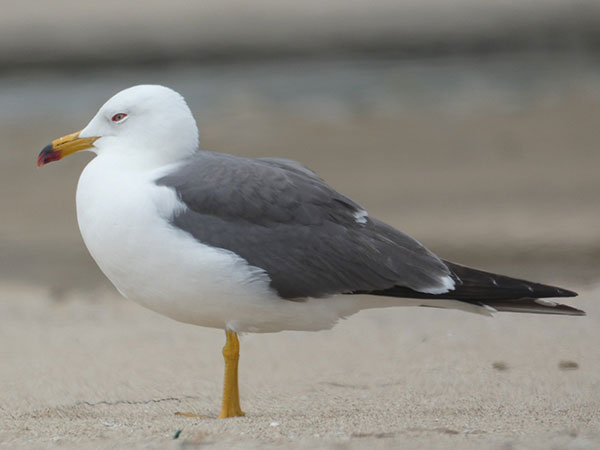
Black-tailed Gull, May 2019 (Malia DeFelice)
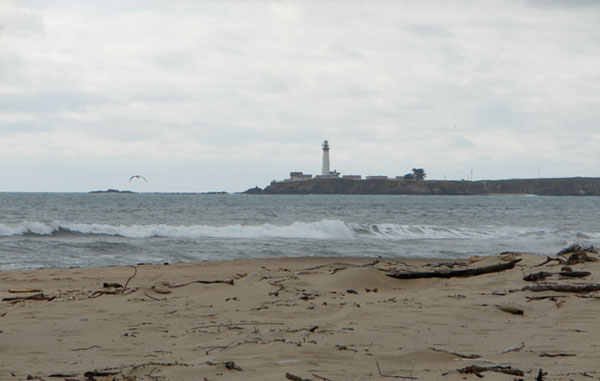
Gazos Creek Beach Access, looking north from beach to Pigeon Point (Jennifer Rycenga)
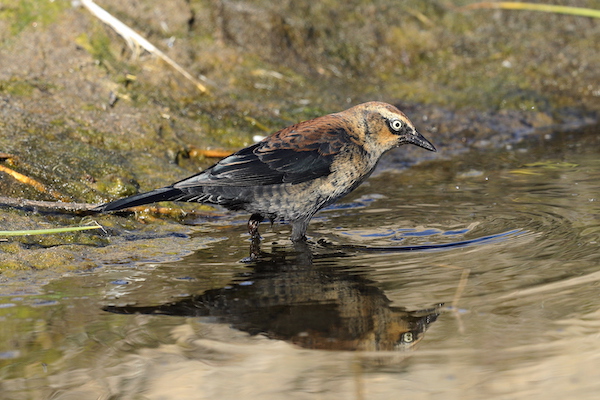
Rusty Blackbird re-enacting the story of Narcissus at Gazos Creek Beach Access, October 2020 (Aaron Maizlish)

Prairie Warbler, Gazos Creek Beach Access, September 2009 (Michael Scott)
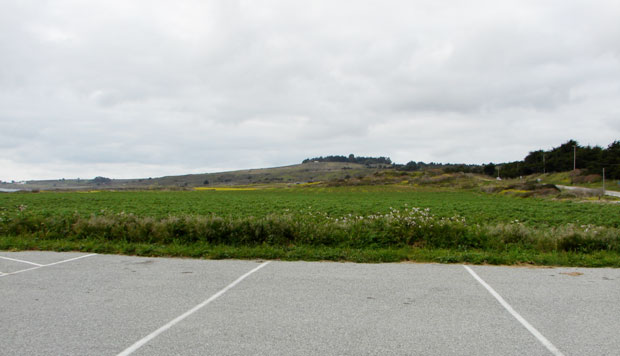
Gazos Creek Beach Access, Agricultural Field noted for Sparrows, looking north from parking area (Jennifer Rycenga)
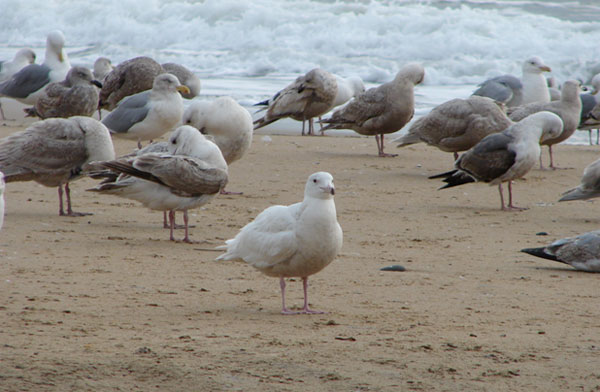
Glaucous Gull, 1st year, Gazos Creek Beach Access, March 14, 2009 (Jennifer Rycenga)
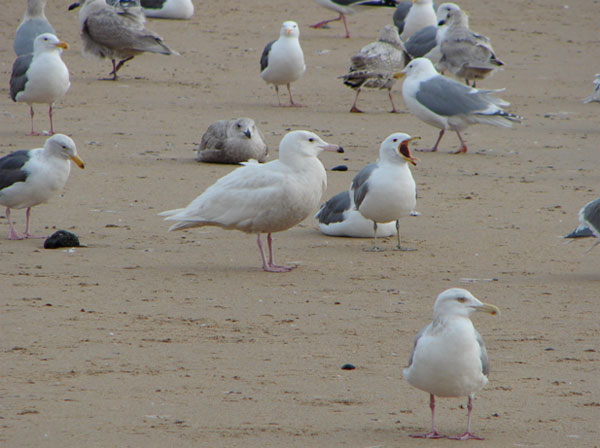
A California Gull objects to what it feels is undue attention to the Glaucous Gull, by sticking out its tongue, March 14, 2009 (Jennifer Rycenga)
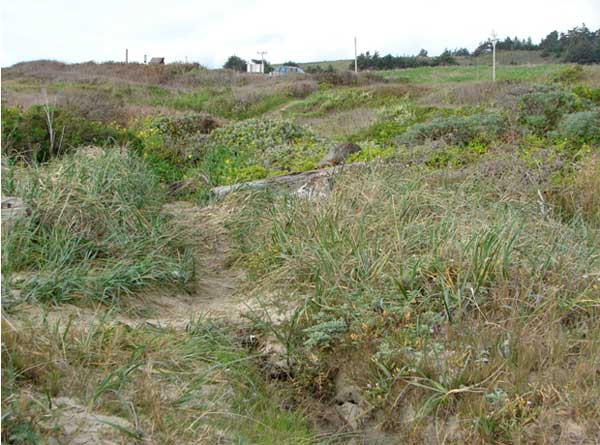
The hike from the beach back to the parking lot at Gazos Creek Beach Access (Jennifer Rycenga)
Author: Jennifer Rycenga, Uploaded: